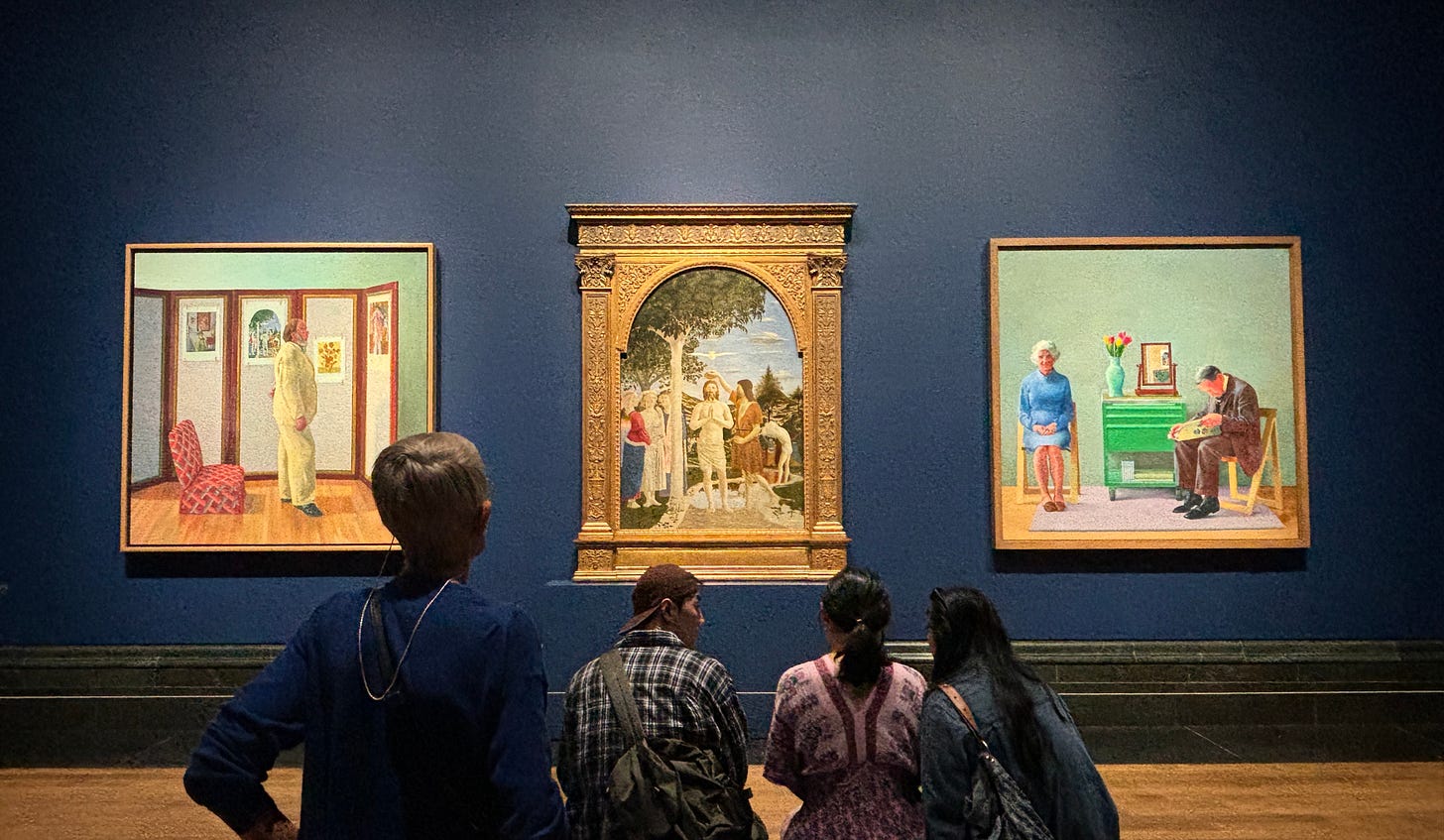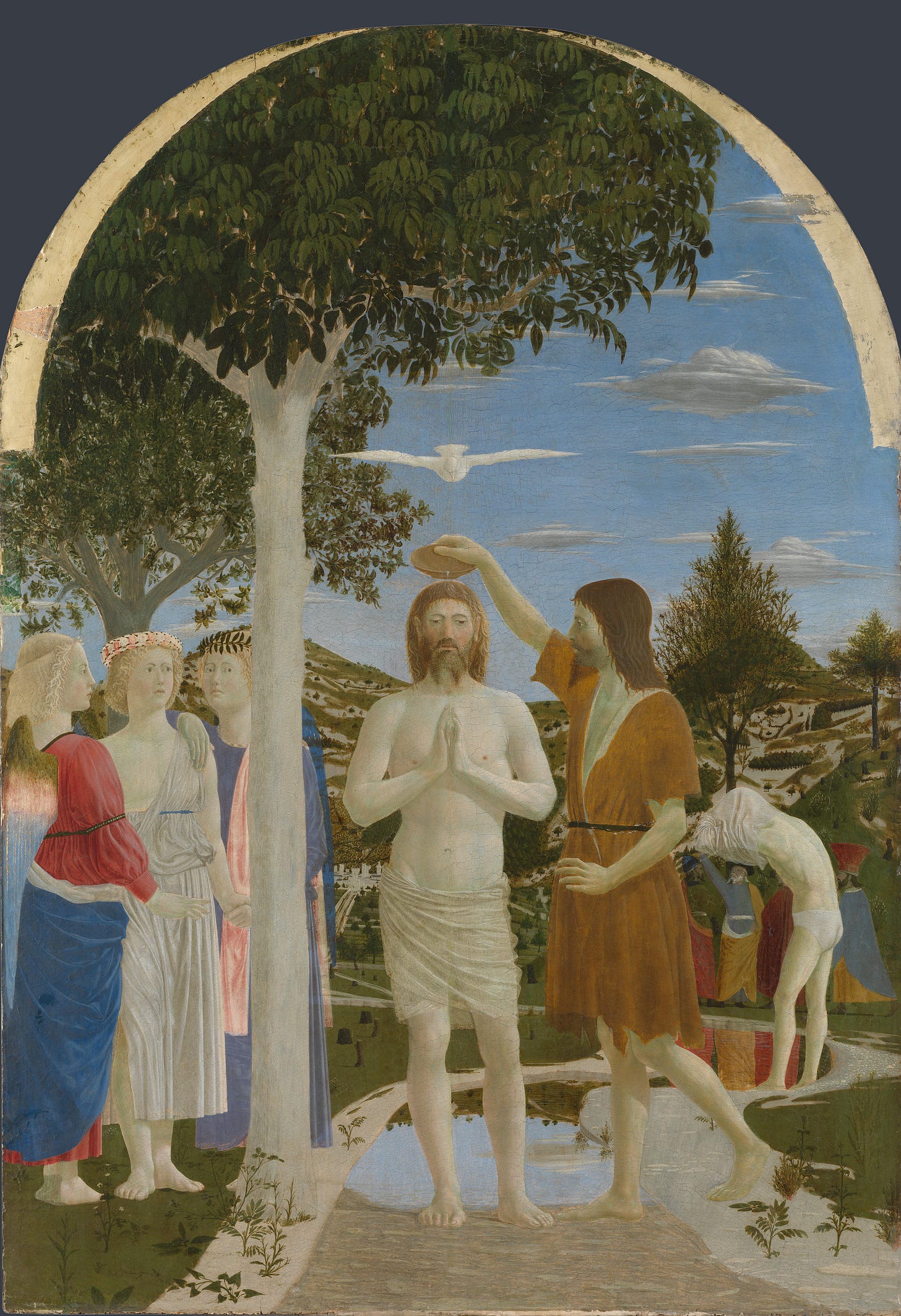The Art of Slow Looking
'Hockney and Piero', on at London's National Gallery until 27 Oct 2024
There’s a small, free, rather unusual, and exceptionally thoughtful exhibition on in London right now. It’s at the National Gallery – and it closes on the 27th of October.
This is Hockney and Piero: A Longer Look. It’s a comparative study of the work of two artists – one contemporary British, the other early Renaissance Italian – who, on the surface, seem totally different, but who, upon closer observation, have quite a lot in common.
The show consists of three pictures: David Hockney’s Looking at Pictures on a Screen and My Parents (both c. 1977). Displayed between them is Piero della Francesca’s fabulous Baptism of Christ (c. 1437–45). It makes a wonderful triptych that works well when you stand back, as they all share the same palette: light, breezy pastels, hints of gold and green, and splashes of red. The curators have painted the walls of the room a deep blue, which really makes these colours pop.
However, to get the full experience of the comparison, you’ll really want to look at them up close: the details make all the difference. Della Francesca’s Baptism is hidden in both of Hockney’s paintings. In Looking at Pictures on a Screen, it’s pasted on the wall behind the art critic. In My Parents, it’s hidden as a reflection in the mirror.


These echoes signify Hockney’s belief in the continuity of great art. He wants the viewer to look closely at his paintings, and in hiding Della Francesca’s masterpiece in plain sight, he’s implicitly showing us that art is really a dialogue between painters. It’s a process of establishing traditions and then innovating upon them. But Hockney invites us to consider how these innovations are, in fact, homages to, rather than divergences from, tradition. We see this here in other, less direct ways: in the technical likenesses between Hockney’s paintings and Della Francesca’s tempera – symmetry, figuration, brightness, and timelessness.
Piero della Francesca’s Baptism of Christ
If I remember correctly, this painting might have been one of the first works I encountered during my Master’s in Renaissance Italian art. This is no surprise: it’s an early Renaissance altarpiece from the mid-fifteenth century (we consider the ‘High Renaissance’ to come slightly after this, in the sixteenth century), so it foregrounds the characteristics of art from that transformative period. We see this in Della Francesca’s considered and nuanced treatment of perspective, composition, light, and symbolism, all of which contribute to the central message of the piece: the intersection between the human and the divine.
This painting is all about symmetry and, therefore, spiritual harmony. The figures of Christ and the Holy Spirit (symbolised by a dove) are anchoring presences in the vertical centre. They separate the secular people on Christ’s left-hand side (the bathers in the background) from the sacred angels on his right. In addition to this left-right divide, there is also an up-down geometry in the painting. The upper part of the image forms a semicircle representing the heavens, while the squared-off verdant landscape at the base signifies the earthly plane. The figure of Christ, as you will notice, transgresses both.
Although the original frame has been lost, the sumptuous, ornate frame currently surrounding the painting (added during restoration in the 19th and 20th centuries) is a crucial part of the viewing experience. This from is a golden portal which separates the spiritual sphere of the painting from the everyday realm of the viewer.
David Hockney’s Looking at Pictures on a Screen and My Parents
David Hockney is one of the most influential and well-known British artists of the 20th and 21st centuries. He’s famous for his mastery of different mediums (from painting to photography, and even iPad drawing), and his style is characterised by vibrant colours and inquisitive perspectives. His most iconic works are the swimming pool paintings he made in Los Angeles in the 1960s. But his best (in my opinion) are the numerous tender, magical portraits of his two fat dachshunds.
Hockney’s pictures in this exhibition bear all his characteristic hallmarks. They’re colourful, but in a sort of 1970s muted way. They play with voyeurism and negative space. They’re both naturalistic and posed, with characters that seem active and engaged, but who aren’t overly energetic. The serene actions of Hockney’s figures – reading, looking, sitting – encourage us to pause and think about them. In this, Hockney’s works absolutely evoke the calm symmetry of Della Francesca’s Baptism. The toothpaste green of Hockney’s walls apes the duck egg blue of Della Francesca’s sky. Della Francesca is literally there in the background, pasted on the screen and reflected in his parents’ mirror.
In Looking at Pictures, as the title suggests, we’re observing someone looking at pictures. The ‘someone’ is an art critic — Hockney’s friend, Henry Geldzahler — and he’s looking at a portable gallery wall containing various different artworks: one by Johannes Vermeer, Van Gogh’s Sunflowers, one by Degas, and Della Francesca’s Baptism. The genres and artists here are diverse, but all of these works hail from the National Gallery, which is a gentle nod to Hockney’s love for their collection.
Geldzahler, interestingly, isn’t looking at the artworks themselves, but at photocopies of them. Perhaps this is comment on the inherent value of reproductions: not just of direct copies, but also of imitations and repurposings, of the kind Hockney is literally doing here.
Hockney’s second painting, My Parents, is more ambiguous. The painting is divided into two distinct halves, with each parent occupying one side. Hockney’s mother, Laura, sits on the left, her posture straight and her gaze directly meeting the viewer’s. She looks calm, composed, and slightly formal. In contrast, his father, Kenneth, sits on the right, bent over in an absorbed posture, focusing on a book. The positioning creates a dynamic wherein his mother is open and engaging, like a portrait sitter, while the father is sitting for us, like a model for a genre painting.
The cabinet behind them holds several books, with one clearly titled Chardin, perhaps referencing the 18th-century French painter known for his still lifes and depictions of domestic scenes. This is an apt allusion for a painting about family and domesticity.
The mirror on top of the cabinet reflects Della Francesca’s Baptism, subtly drawing attention to the fact that Hockney’s My Parents does not exist in a vacuum but that — like all paintings — its an apotheosis of all the art that was made before.
It suggests that in looking at art we are also being looked at by art. Indeed, in this painting, we certainly are, and in more ways than one: firstly, in the reflection in the mirror, and secondly, in Hockney’s mother’s equivocal gaze.
Hockney’s point is clear: there can be no progress without continuity, and great art never dies.
And also, more than either of these, it’s simply a reminder to look slowly.









I loved this for a few different reasons… first, I love the feeling of connection through the three paintings, somehow now all three of them cater deeper meaning, a secret thread. And also, your final paragraphs…
Last year, I challenged myself to spend 30 days with art—each day, I would sit with one work of art for 10 minutes, just looking. At first, I didn’t realize that it wasn’t just about seeing; it was about letting go. Allowing the art to look back at me, loosening my grip on control, and allowing myself to be moved in ways I couldn’t understand.
I enjoyed your piece. I have a comment and a question. The comment: I find it interesting that you think the woman in My Parents looks ready to engage. My initial reaction was that she looked very passive and seemed to be meekly waiting for him to look up and pay attention.
My question: is the picture that the critic is viewing in Looking at Pictures a specific Degas or just in the style of Degas? The angle makes it hard to recognize.